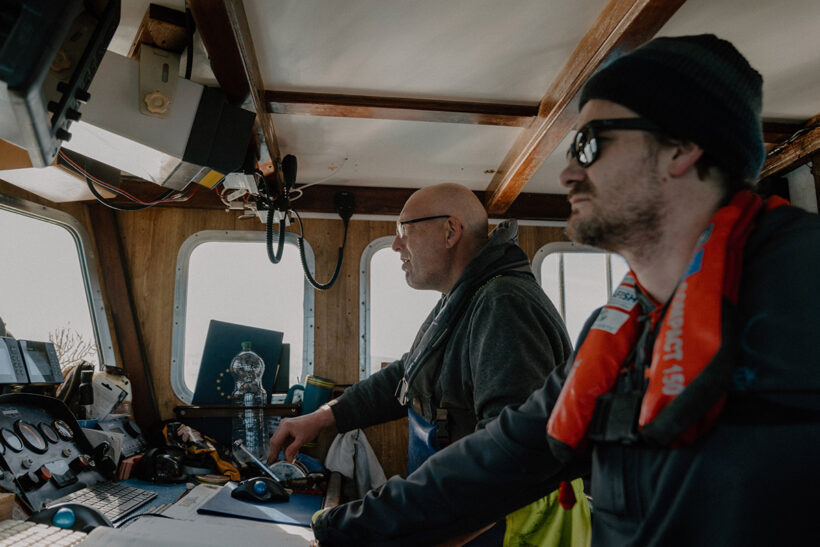A lucky observation during pot light trials has now been developed into a realistic prospect for a new, sustainable fishery
The story about ‘scallop discos’ made news way beyond the fishing world in 2022, but behind the headlines, much hard work, engineering and science remained to be done before the concept was engineered into a successful and profitable scallop pot fishery.
Although relatively unknown across the UK industry before the media frenzy last year, Devon-based company Fishtek Marine in fact has a long history of working with the fishing industry at the sharp end – albeit much of this elsewhere in the world.
“One of the biggest successes we’ve had, in a 20-plus-year history on working on new solutions to improve fishing performance, has been in the snow crab fishery that operates from Alaska across the polar seas to Canada and northern Russia,” Rob Enever (pictired above), head of science and uptake at Fishtek, told me when I arrived at its main production unit near Totnes, in Devon.
“The snow crab fishery is huge, but also at risk due to potential interactions with endangered cetaceans, including right whales, and under huge pressure to minimise risks of interaction.
“This fishery is mostly in deeper water below 100 fathoms, and we were aware that there was the potential for lights to increase efficiency of the catches there. The fishery is restricted by quotas, so the greater the efficiency of each pot, the fewer the number of downlines, and the lower the risk of any interaction with endangered mammals.
“When we started research into this, there was no ‘off the shelf ’ solution, and we had to both learn about the best way to improve pot efficiency, and at the same time develop a product that was robust, reliable and cost-effective.
“We got there in the end, and we now see our lights used across the fishery, down to depths of 1,000m, with a bespoke solution that costs the fisherman less than $10 per light, delivered to the vessel.
“In this fishery, we eventually settled on a green/ white light combination that maximised the effectiveness of the traps, after a lot of trial and error. The results of the work we did was fully evaluated by scientists, who confirmed a 70% increase in pot efficiency overall, with the most successful trials seeing an increase of 76%.
“As well as this, we are also seeing skippers using significantly less bait, in a fishery involving large numbers of huge pots, and where the volume of bait used would make eyes water in the UK.
“Involving scientists was a crucial step in our work, which has always been underpinned by the best science possible.”
The use of light in pot fisheries, however, is very variable between species and fisheries, and requires carefully controlled trials in each new environment. It is not something that would have led to the breakthrough with scallop potting, without the eagle eyes of fisherman Jon Ashworth.
“We gave Jon 100 of the lights we are now supplying across the snow crab fishery,” Rob explained, “to see what impact they had on brown crab and lobster catch rates. The answer, in this case, was ‘zero’, although the increase in spider crab catches was 300%, which shows how unpredictable this work can be.
“However, John did notice a few scallops in the pots – one fleet of gear had 10 shells in it – and he mentioned this to us. It piqued our interest, and working with scientists at Exeter University, we rapidly reconfigured the trials.
“This didn’t have huge catch rates – we finished with 0.3 scallops per pot per haul, in the pots where we had lights – but the statistics around this were compelling. Basically, pot with lights equals scallops; pot without lights equals no scallops. But again, for brown crab and lobster, lights had no impact at all on catch rates.
“Media interest in these first results was intense – ‘scallop discos’ were mentioned across the media. From our point of view, the next step was expanded trials, over 18 months, that we have now completed and the scientists are writing up. This second trial involved fishermen from around the British Isles, and will be published later this summer.
“We looked at a range of variables, including light intensity, colour, the use of flashing lights, the pot/ trap design and the fishing method. The funding we received through Defra’s Seafood Innovation Fund, Natural England and The Fishmongers’ Company enabled us to put together really good experimental protocols with the different commercial fishermen we were partnering with, to really get to grips with the most effective way to make the concept work.
“To support this, and further ongoing research, we also took the decision to invest in tank facilities ashore. These are expensive, but will save huge amounts of trial and error at sea.
“Using the best combination of light colour, intensity, duty cycle and trap design, we were able to improve the catch rate of scallops retained by the traps in the initial feasibility study by 500%. Average scallop retention across all at-sea trials was just under two scallops per pot per haul, with a maximum number of scallops recorded in a string averaging 26 scallops per pot.”
Now that the trials are completed, Fishtek says, the time is ripe to move on to the third step in developing a new, low-impact and sustainable fishery, and work with fishermen to create the critical mass needed for a permanent high-value market for the scallops caught.
“At the moment, we are seeing a really wonderful niche product, being caught by forward-thinking fishermen and sold at high prices to local outlets,” said Rob. “The next step will be for a larger fishery, and group of vessels, to get together to generate the volume needed for a much larger supplier or market. Talks about this are ongoing, and I hope will soon confirm the next step in the development of the fishery.”
Skipper’s Experience | Falmouth: ‘I no longer need to use bait’
Jon Hays, who works his crabber Our Pammy out of Falmouth, has enjoyed his participation in the scallop potting trials, he told Fishing News. Unlike some of the other fishermen involved, he is happy, in some areas, to fish purely for scallops using the lights – but no bait.
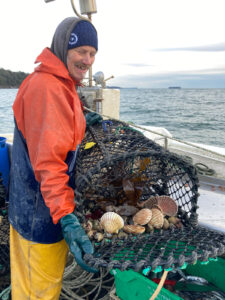
Jon Hays with the catch from one of the pots used in the trials he undertook to evaluate the effectiveness of the lights. When targeting scallops, he no longer uses pot bait at all.
Jon’s original involvement in the trials was to evaluate catch rates in control pots compared to ones fitted with the standard light. Other work in Devon, Yorkshire and the Isle of Man investigated other variables such as light colour and intensity, and different design of the pot entrances.
“I am primarily a crab and lobster fisherman,” he explained, “but have found areas where targeting scallops makes sense. I’d give these a slightly longer lie than I would the baited crab pots, which I like to get in every 48 hours at least, and with these I’ll continue to use both bait and the lights, for a mixed catch.
“All my initial trials were on crab ground, where we have known there were scallops, but I am looking now at a few patches within the areas closed to scallopers, purely targeting scallops themselves. These are slightly different grounds from my normal crabbing haunts.
“I’ve had a bit of time at this now, and am starting to learn the ropes. We are seeing fairly consistent catch rates, and there are no signs yet that we can fish a patch down. This is all shallow ground, and we can see from the growth rings that the scallops here are really fast-growing, which I’m sure helps. Prices per scallop that we’re getting are really excellent.
“Looking at the money side of things, the light and battery costs are much lower than using baited pots for crab. It actually pays off, even though we are not yet getting the recognition from buyers of the extra quality of the scallops we land.
“I see this, though, as being part of mixed fisheries going forward, and not a switch 100% to scallops. Relative to fishing for crab and lobster, for the two weeks of neap tides in the cycle, potting for scallops is viable, but it isn’t worth fishing across spring tides.
“I do see this now as a permanent part of my job, not simply an experiment. My missus loves it too – I’ll regularly take home half a dozen scallops for her at the end of the day – one of her favourites!”
Skipper’s Experience | Whitby: ‘This can now make the basis of a viable business’
Whitby fisherman James Cole originally agreed to work with Fishtek in trials looking at catch rates between baited pots with lights, and control pots without.
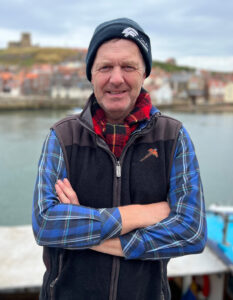
One of Whitby fisherman James Cole’s roles in the project was to work strings of pots with a mix of lights and no lights, recording the
differences in the pots of crab, lobster and scallops
Like Jon Hays, he sees a scallop fishery not as a potential new fishery, but something that is confirmed as a viable source of income already, for fishermen with the right gear.
“The market value we were getting for the scallops we caught in the trials was way above that of dredgecaught scallops, all bought and consumed locally in local restaurants and hotels. We can easily sell everything we catch.
“The fishery for scallops was hit and miss, especially at the start of the trials, and a bonus addition to the income in the pots from crab and lobster, but gradually we learned where the scallops lie, and how to target them.
“For example, I’ve found a few ridges down at 25-30 fathoms, and by following the line where the scallops back up, along the bottom of the ridge, we’ve done well.
“I normally work fleets of 40 pots. Through the trials themselves I was working fleets of 21, to keep to the science protocol agreed. Even with just 14 of these 21 using lights, some lifts during the trials I was making more money than in my normal fleets of 40 during neap tides. Any tides above about 4.6 or 4.8, we see a rapid drop-off in catch rates.
“This has all been on ground where the scallop fleet don’t fish – there is one box they fish that we avoid, but primarily we don’t have interactions with the scallop fleet here.”
Where it started: the snow crab fishery
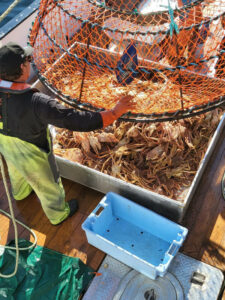
Nothing is small in the snow crab fishery! The pot lights have increased catch rates in the pots by over 70%, and allowed many skippers to reduce bait bills into the bargain. (Photo: Chantier Naval Forillon)
The first pot lights successfully developed by Fishtek, which led to the scallop project, were investigated by scientists from Trondheim and Tromsø in Norway, and from DTU Denmark – the same university that documented the successful use of fish traps for cod in the Baltic (Fishing News, 23 March, ‘Beating the seal explosion: Lessons from the Baltic’).
The scientists investigated the impacts of lights in pots used by a large 55m crabber, of 2,250hp, working a total of 9,000 traps, of which it was lifting roughly 2,000 a day, from depths of 250m and deeper. Think The Deadliest Catch and you’ll get the idea. The pots are fished 30m apart, as is standard across the fleet in this fishery.
Both green and white lights were trialled, with pots having soak times of between eight and 14 days. All the pots were baited, each with 800g of squid, the standard bait used in the fishery.
The results were unequivocal, the scientists reported. Green light used within the pots increased catches of crabs above MLS by 76%, and white light by between 52% and 54%.
The use of lights in the fishery are now widespread. Some owners also report bait savings when the lights are used, reducing overall costs in the fishery. As Fishtek found in UK waters, brown crab and lobster hadn’t read the report, and had no interest in the lights – each fishery needs its own investigations and own tweaks to maximise the benefits of the new technology.
Test tank: ‘Investment has saved fishermen years of tweaking
Following the initial results on catching scallops in creels, Fishtek made a decision to invest in recirculated tanks in which to carry out detailed experiments on the behaviour of different animals in response to underwater light.

Scallops in the tank just as the pot lights are turned on. The ‘red’ lights in the picture are actually infrared and are invisible to the scallops. The overhead cameras, and cameras inside the pots, can allow detailed analysis of
each individual scallop movement, for up to 31 hours, allowing the team to build up a really accurate picture of the scallops’ behaviour
“We realised that fishermen have long been able to work on gear, fine-tune it, and gain a real understanding of what works where, in what conditions – but this all takes them time and effort, whilst they are also making their living,” explained Rob Enever.
“As we moved to phase two of this scallop light project, we made a decision to invest in tanks, high-resolution cameras, processing software and the human expertise needed to really drill down on perfecting the lights for use in each different fishery, and also ensuring we have the most effective design for static gear. That is where Tom Day comes into the frame.”
Tom joined the project from Exeter University, which is building a reputation for practical and applied fisheries research, and is partnering a number of different initiatives with the fishing industry – one of which is the work with Fishtek.
When I joined Tom in the tank room, he was undertaking work on the efficiency of the modified traps in retaining scallops.
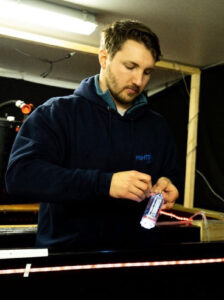
Tom Day at work in the tank room.
He explained: “We’ve set the tanks up so that we have two bird’s-eye cameras, and in this instance, a camera in the pot itself. What I am looking at today is not how the scallops get into the modified pot, but if any of them can get out. The scallop lights themselves are outside the pots, and the scallops are trying to escape.”
The tanks work on recirculated sea water, which is replaced routinely. The scallops are fed in separate tanks with a mixture of prepared phytoplankton. The tanks in which the filming takes place have little food for them, if any, as this is thought likely to stimulate the scallops to move in search of currents bearing food particles.
The water temperature, of 13-14°C, is designed to be comfortable for the scallops, to enable them to maintain mobility, and keep them in good condition for as long as possible.
However, even so, the scallops are replaced every few weeks with fresh ones. This is also the case with other work Tom has been doing with crab and lobster, and potentially in the future with fish species.
The tanks allow everything to be fine-tuned, from the light intensity and colour to the actual spread of the lights used, and precise analysis of the way that the scallops orientate themselves and move. Very small tweaks to the designs of the modified scallop pots can also be analysed in detail – something Tom said was important to improve overall efficiency of the entrances themselves.
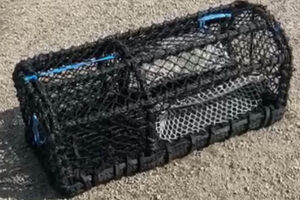
Several designs of entrance have been tested in the tanks, being tweaked each time to improve catch retention of crab, lobster and scallops, whilst maintaining easy access for all three species.
“Scallops are really surprisingly accurate swimmers,” he told me. “They don’t just flap roughly towards the light source – they know exactly where they are going.
“Once they are orientated, they’ll first spin themselves on the sand that we have at the bottom of the tanks, quite carefully, and only when in line with the light source will they swim towards it, very accurately, and in a completely straight line.
“We’ve found that building a trap that retained the scallops once they’d entered was pretty straightforward. The bigger challenge was a trap that would retain crab and lobster as effectively as a conventional pot, but that would also let scallops enter easily. This took more modifications, this time using hungry crabs in the pots, with bait outside to encourage the escape response.
“We’re confident now that we have an optimal solution – though of course fishermen will always be tweaking their gear to take account of local conditions and behaviour.”
This solution is aimed at informing the best designs for a combined scallop and crab fishery – but there is plenty of interest worldwide in other species, not just of crustaceans, but also of fish. Fishtek has already been working in Alaska on the cod trap fishery there, and there has been a surge of interest in the use of lights in other fisheries.
“The tanks can save a lot of time on the early research,” Tom concluded. “We know that finfish react to very different light frequencies than the shellfish, and we are also seeing shellfish exhibit different requirements. With the tanks we can very quickly drill down on what doesn’t work at all, and what may – and then work with fishermen to fine-tune the gear, and the technology within it, to maximise benefits.
“I’m really looking forward to seeing the gear we’ve already fine-tuned for scallops come into much wider use, but also to starting work on new species, and new fisheries. We very much see this as the start of a process, not the end.”
This story was taken from the latest issue of Fishing News. For more up-to-date and in-depth reports on the UK and Irish commercial fishing sector, subscribe to Fishing News here or buy the latest single issue for just £3.30 here.
Sign up to Fishing News’ FREE e-newsletter here.



